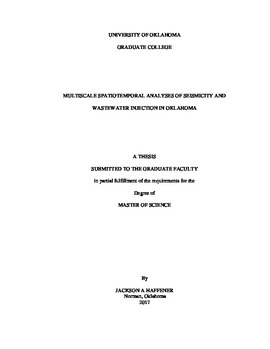| dc.description.abstract | The increase in seismicity in Oklahoma since 2009 has been primarily attributed to wastewater disposal, however, the extent and nature of the relationship is not clear. On the state level, there is no statistically significant relationship between injection volume and nearby seismic activity for individual wells. However, there is a clear trend between combined regional injection volumes and seismicity. This relationship requires a minimum association distance of 25 km to emerge and 40 km to stabilize. Analysis of the temporal relationship seen between injection and seismicity shows a clear 215-day delay at the state level and time delay between 0 and 180 days at a 20 km spatial scale. The time delay exhibits spatial variability, which may suggests spatial heterogeneity in the hydraulic fluid properties. Furthermore, clusters of seismicity are used to understand the underlying triggering processes and fluid movement in Oklahoma. Around 52% of the seismic clusters in Oklahoma show statistically significant diffusive migration, which is an indicator of pore pressure triggering, with a mean diffusivity around 0.05 m2/s. At the regional scale, there are also signs of diffusive migration away from areas with high injection rates with an average diffusivity of 1.8 m2/s. The large-scale diffusion likely reflects the pressure front propagation within the Arbuckle Group, compared to the cluster based diffusion showing pressure movement in the crystalline basement within a single fault system. Finally, the individual clusters show the majority of earthquakes occur along steeply dipping seismogenic faults that have strike directions between 30° and 120° E. Many of these seismogenic faults occur on sub-optimal fault orientations based on fault hazard maps, suggesting current fault hazard assessment may not properly represent the actual hazard. | en_US |
